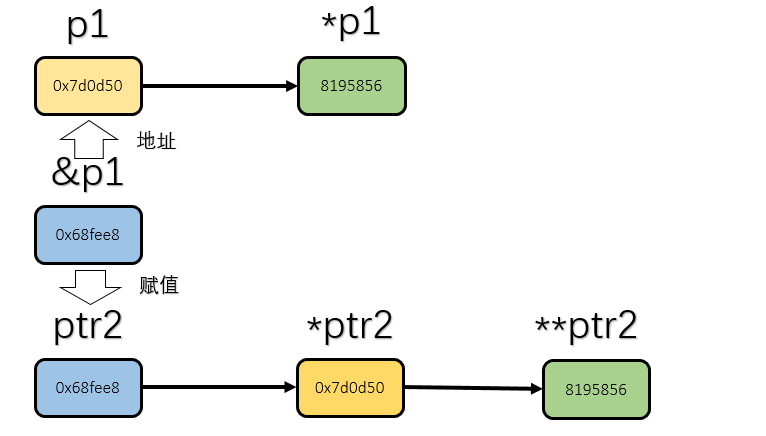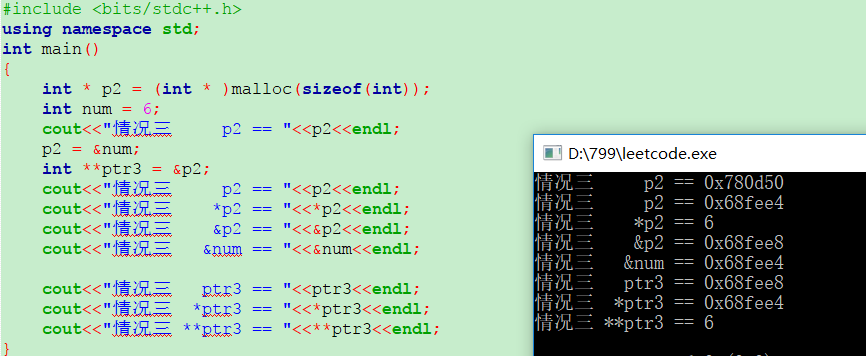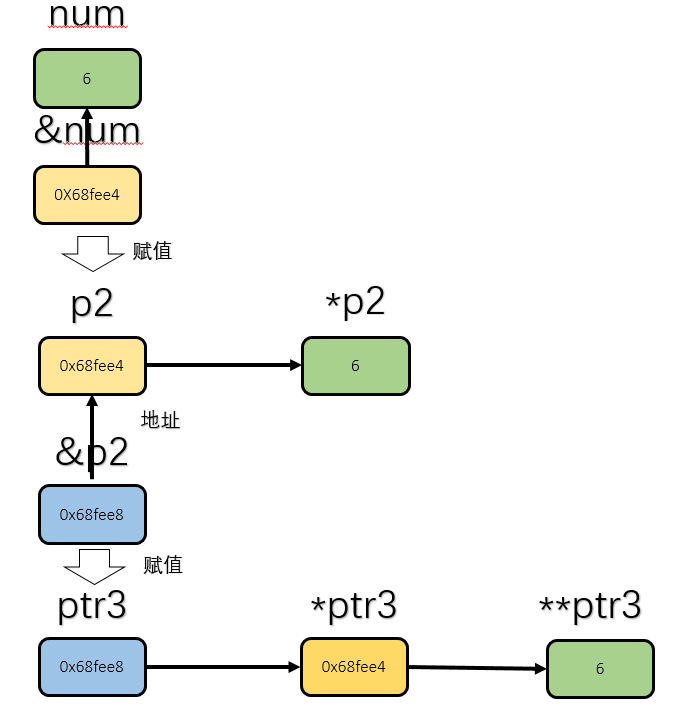二重指针
例子1:
-
Question
int **ptr1 = NULL;
cout<<"情况一 ptr1 == "<<ptr1<<endl;
cout<<"情况一 *ptr1 == "<<*ptr1<<endl;
cout<<"情况一 **ptr1 == "<<**ptr1<<endl;
/// 输出 :0 非法 非法
-
Reason:
1) 三省指针: 指针 ptr1 的类型是 int ** ,指向的类型 int*, 指定为空
2) *ptr1 是 ptr 指向的指向 ,即空的指向,非法
3) **ptr1 是 ptr 指向的指向的指向 ,即空的指向的指向,非法
例子2:
-
Question
int * p1 = (int * )malloc(sizeof(int));
int **ptr2 = &p1;
cout<<"情况二 ptr2 == "<<ptr2<<endl;
cout<<"情况二 *ptr2 == "<<*ptr2<<endl;
cout<<"情况二 **ptr2 == "<<**ptr2<<endl;
-
Practice:
#include <bits/stdc++.h>
using namespace std;
int main()
{
int * p1 = (int * )malloc(sizeof(int));
int **ptr2 = &p1;
cout<<"情况二 p1 == "<<p1<<endl;
cout<<"情况二 *p1 == "<<*p1<<endl;
cout<<"情况二 &p1 == "<<&p1<<endl;
cout<<"情况二 ptr2 == "<<ptr2<<endl;
cout<<"情况二 *ptr2 == "<<*ptr2<<endl;
cout<<"情况二 **ptr2 == "<<**ptr2<<endl;
}

-
Reason:

1)三省指针:指针 p 的类型是 int * ,指向的类型 int, 初始化为没有指定其指向
2)三省指针: 指针 ptr2 的类型是 int ** ,指向的类型 int*, 指针p的地址 (注意此时 ptr2 与 &p 类型相同 都是 int** ,才可以赋值)
3)*ptr2 是 ptr2 指向 ,即&p1的指向,为p1
4)**ptr2 是 ptr2 指向的指向 ,即*ptr2的指向,为*p1
5)指针即是地址,所以 看作 &p1 指向 p1
例子3:
-
Question
int * p2 = (int * )malloc(sizeof(int));
int num = 6;
p2 = #
int **ptr3 = &p2;
-
Practice:
#include <bits/stdc++.h>
using namespace std;
int main()
{
int * p2 = (int * )malloc(sizeof(int));
int num = 6;
cout<<"情况三 p2 == "<<p2<<endl;
p2 = #
int **ptr3 = &p2;
cout<<"情况三 p2 == "<<p2<<endl;
cout<<"情况三 *p2 == "<<*p2<<endl;
cout<<"情况三 &p2 == "<<&p2<<endl;
cout<<"情况三 &num == "<<&num<<endl;
cout<<"情况三 ptr3 == "<<ptr3<<endl;
cout<<"情况三 *ptr3 == "<<*ptr3<<endl;
cout<<"情况三 **ptr3 == "<<**ptr3<<endl;
}

-
Reason:

1)三省指针:指针 p2 的类型是 int * ,指向的类型 int, 初始化 没有指向,后指向为&num(注意此时 p2 与 &num 类型相同 都是 int* ,才可以赋值)
2)三省指针: 指针 ptr3 的类型是 int ** ,指向的类型 int*, 指针p2的地址 (注意此时 ptr2 与 &p2 类型相同 都是 int** ,才可以赋值)
3)*ptr3 是 ptr3 指向 ,即&p2的指向,为p2
4)**ptr3 是 ptr3 指向的指向 ,即*ptr3的指向,为*p2
5)指针即是地址,所以 看作 &num 指向 num,看作 &p2 指向 p2
吐吐吐吐吐吐吐槽:写博客好累啊啊啊啊啊,博客园为啥这么不好用,是我打开的方式不对吗????